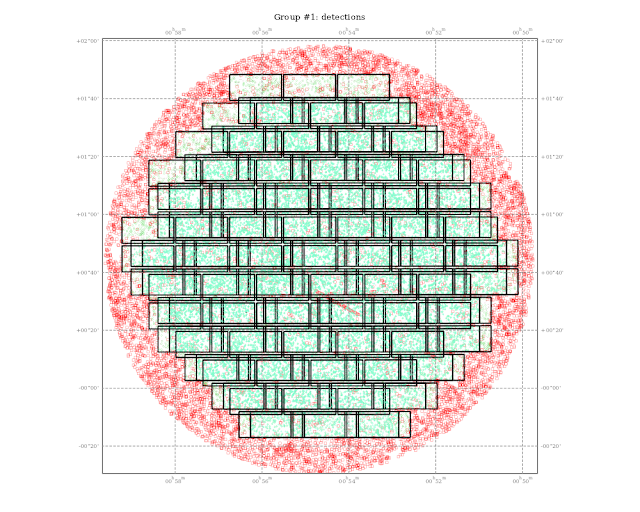One of the most critical parts of data reduction for multi-chip cameras such as DECam is to pin down the precise location of the images on sky, and to correct for optical distortions and other aberrations. Otherwise many individual exposures of the same field cannot be registered and combined to create a deep image. This is quite a complex task as numerous parameters have to be solved for.
It starts with correcting for the pointing offset.... the actual position on sky the telescope looks at, and the position the telescope control system _thinks_ it is looking at. The same holds for the rotation on sky. The pixel scale is not known precisely either, nor is the relative orientation and position of DECam's 62 main imaging detectors. In an ideal world, all detectors would be co-planar and parallel to each other, but in real life small deviations exist which must be corrected for. To make things worse, we have to correct for differential atmospheric refraction, which compresses the image along one direction, and various optical aberrations such as focal plane curvature, distortion, etc. Fortunately, most aberrations are being take care of by DECam's gigantic field corrector lenses, and distortions are expected to be minimal.
Ultimately, all these parameters are determined by comparing tens or hundreds of thousands of stellar positions in the DECam images against an equally large number of cataloged astrometric reference sources. Fortunately, there are excellent software tools available that can handle this task quickly, such as Scamp (www.astromatic.net).
After correcting for a sign error in the CD matrix (CD1_2 must be positive, and CD2_1 negative, corresponding to North being left, and East being up in the DECam images), and a 15 arcminute pointing error, the correct WCS (world coordinate system) solution dropped out of Scamp immediately for various different areas on sky.
Below you can see the pointing map, showing three dithered DECam exposures. Red points are astrometric reference sources, and in green you can see the objects detected in the images which could be matched with the reference catalog.

The second plot shows the optical distortion, expressed as a change of pixel scale as a function of position on the detector array. Pixels in the center of the detector array see a slightly larger area on the sky than those outside. A quadratic polynomial was used to fit the distortions per CCD. Obviously, the fit is not perfect yet as the real optical distortion is smooth and radially symmetric. This is because DECam's field corrector was designed to deliver very small distortions which are hard to measure. And indeed this is the case... from the center to the edge of the field the pixel scale changes by only 0.5%. Across one of the 62 CCDs the pixel scale changes by at most 0.0005". In other words, the size of the image delivered by one CCD (2000x4000 pixels) will change by not more than 1 pixel after correcting for distortion. To measure such small effects with great reliability, we need to observe fields with much higher stellar density than the ones used to obtain this first WCS solution.
The last plot shows the astrometric residuals in x- and y-direction, as a function of x and y position on the detector array for those three dithered exposures and the shown distortion map. The rms is about 0.03", in other words, the images were registered with an accuracy of almost 1/10th of a pixel (one DECam pixel measures 0.27"). And even more importantly, systematic deviations are absent.
This is great news as an accurate and precise alignment of multiple exposures is critical for any astronomical observation. As commissioning of DECam proceeds, we will be able to constrain the various WCS parameters even further.


No comments:
Post a Comment